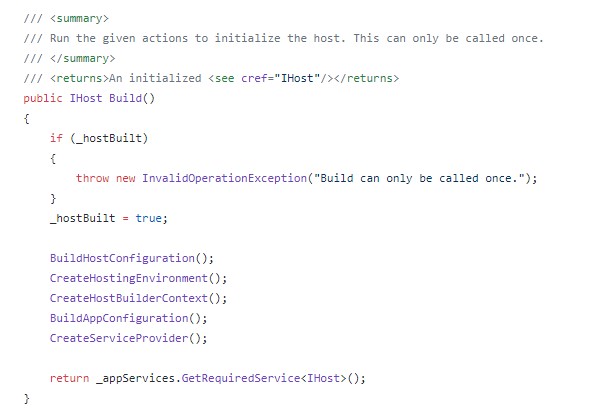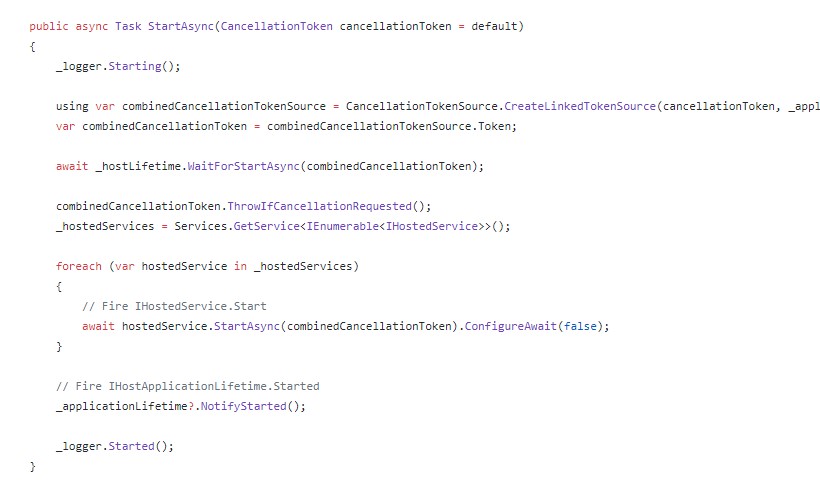当我们将原有ASP.NET 应用程序升级迁移到ASP.NET Core之后,我们发现代码工程中多了两个类Program类和Startup类。
接下来我们详细探秘一下通用主机Host的启动过程。
一、Program类的Main函数入口
Program类最重要的功能就是启动主机,这里有一个主机的概念,是ASP.NET Core全新引入的。
主机负责应用程序启动和生存期管理。 同时,主机也是封装应用程序资源的对象:
- 依赖注入 (DI)
- Logging
- Configuration
- IHostedService 实现
启动主机时,它在 DI 容器中找到 IHostedService 的每个实现,然后调用 IHostedService.StartAsync。 在 web 应用中,其中一个 IHostedService 的实现是启动 HTTP 服务器实现的 web 服务。这里的HTTP服务器默认是Kestrel。
即:ASP.NET Core主机启动时,会启动一个HTTP服务器,默认是Kestrel。启动后监听并响应某个端口的HTTP请求。
我们继续看Program类的代码:

从上述代码可以看到,Main函数中首先调用CreateHostBuilder方法,返回一个IHostBuilder。然后调用IHostBuilder.Build()方法完成
二、Host.CreateDefaultBuilder(args): 构造IHostBuilder的默认实现HostBuilder
在CreateHostBuilder方法内部,首先调用了Host.CreateDefaultBuilder构造了一个HostBuilder,这个我们先看下源码,看看到底Host类内部做了什么操作:
https://github.com/dotnet/extensions/blob/release/3.1/src/Hosting/Hosting/src/Host.cs
public static IHostBuilder CreateDefaultBuilder(string[] args)
{
var builder = new HostBuilder();
builder.UseContentRoot(Directory.GetCurrentDirectory());
builder.ConfigureHostConfiguration(config =>
{
config.AddEnvironmentVariables(prefix: "DOTNET_");
if (args != null)
{
config.AddCommandLine(args);
}
});
builder.ConfigureAppConfiguration((hostingContext, config) =>
{
var env = hostingContext.HostingEnvironment;
config.AddJsonFile("appsettings.json", optional: true, reloadOnChange: true)
.AddJsonFile($"appsettings.{env.EnvironmentName}.json", optional: true, reloadOnChange: true);
if (env.IsDevelopment() && !string.IsNullOrEmpty(env.ApplicationName))
{
var appAssembly = Assembly.Load(new AssemblyName(env.ApplicationName));
if (appAssembly != null)
{
config.AddUserSecrets(appAssembly, optional: true);
}
}
config.AddEnvironmentVariables();
if (args != null)
{
config.AddCommandLine(args);
}
})
.ConfigureLogging((hostingContext, logging) =>
{
var isWindows = RuntimeInformation.IsOSPlatform(OSPlatform.Windows);
// IMPORTANT: This needs to be added *before* configuration is loaded, this lets
// the defaults be overridden by the configuration.
if (isWindows)
{
// Default the EventLogLoggerProvider to warning or above
logging.AddFilter<EventLogLoggerProvider>(level => level >= LogLevel.Warning);
}
logging.AddConfiguration(hostingContext.Configuration.GetSection("Logging"));
logging.AddConsole();
logging.AddDebug();
logging.AddEventSourceLogger();
if (isWindows)
{
// Add the EventLogLoggerProvider on windows machines
logging.AddEventLog();
}
})
.UseDefaultServiceProvider((context, options) =>
{
var isDevelopment = context.HostingEnvironment.IsDevelopment();
options.ValidateScopes = isDevelopment;
options.ValidateOnBuild = isDevelopment;
});
return builder;
}
从上述代码中,可以看到CreateDefaultBuilder内部构造了一个HostBuilder,同时设置了:
- 将内容根目录(contentRootPath)设置为由 GetCurrentDirectory 返回的路径。
- 通过以下源加载主机配置
- 环境变量(DOTNET_前缀)配置
- 命令行参数配置
- 通过以下对象加载应用配置
- appsettings.json
- appsettings.{Environment}.json
- 密钥管理器 当应用在 Development 环境中运行时
- 环境变量
- 命令行参数
- 添加日志记录提供程序
-
- 控制台
- 调试
- EventSource
- EventLog( Windows环境下)
- 当环境为“开发”时,启用范围验证和依赖关系验证。
以上构造完成了HostBuilder,针对ASP.NET Core应用,代码继续调用了HostBuilder.ConfigureWebHostDefaults方法。
三、IHostBuilder.ConfigureWebHostDefaults:通过GenericWebHostBuilder对HostBuilder增加ASP.NET Core的运行时设置
构造完成HostBuilder之后,针对ASP.NET Core应用,继续调用了HostBuilder.ConfigureWebHostDefaults方法。这是一个ASP.NET Core的一个扩展方法:

我们继续看ConfigureWebHostDefaults扩展方法内部做了哪些事情:
using System;
using Microsoft.AspNetCore.Hosting;
using Microsoft.AspNetCore;
namespace Microsoft.Extensions.Hosting
{
/// <summary>
/// Extension methods for configuring the IWebHostBuilder.
/// </summary>
public static class GenericHostBuilderExtensions
{
/// <summary>
/// Initializes a new instance of the <see cref="IWebHostBuilder"/> class with pre-configured defaults.
/// </summary>
/// <remarks>
/// The following defaults are applied to the <see cref="IWebHostBuilder"/>:
/// use Kestrel as the web server and configure it using the application's configuration providers,
/// adds the HostFiltering middleware,
/// adds the ForwardedHeaders middleware if ASPNETCORE_FORWARDEDHEADERS_ENABLED=true,
/// and enable IIS integration.
/// </remarks>
/// <param name="builder">The <see cref="IHostBuilder" /> instance to configure</param>
/// <param name="configure">The configure callback</param>
/// <returns>The <see cref="IHostBuilder"/> for chaining.</returns>
public static IHostBuilder ConfigureWebHostDefaults(this IHostBuilder builder, Action<IWebHostBuilder> configure)
{
return builder.ConfigureWebHost(webHostBuilder =>
{
WebHost.ConfigureWebDefaults(webHostBuilder);
configure(webHostBuilder);
});
}
}
}
© 2020 GitHub, Inc.
首先,通过类GenericHostWebHostBuilderExtensions,对IHostBuilder扩展一个方法:ConfigureWebHost:builder.ConfigureWebHost
在这个扩展方法中实现了对IWebHostBuilder的依赖注入:即将GenericWebHostBuilder实例传入方法ConfigureWebHostDefaults内部
using System;
using Microsoft.AspNetCore.Hosting;
using Microsoft.Extensions.DependencyInjection;
namespace Microsoft.Extensions.Hosting
{
public static class GenericHostWebHostBuilderExtensions
{
public static IHostBuilder ConfigureWebHost(this IHostBuilder builder, Action<IWebHostBuilder> configure)
{
var webhostBuilder = new GenericWebHostBuilder(builder);
configure(webhostBuilder);
builder.ConfigureServices((context, services) => services.AddHostedService<GenericWebHostService>());
return builder;
}
}
}
通过GenericWebHostBuilder的构造函数GenericWebHostBuilder(buillder),将已有的HostBuilder增加了ASP.NET Core运行时设置。
。。。
先看到这,让我们回到ConfigureWebHostDefaults:
将上面两段代码合并一下进行理解:ConfigureWebHostDefaults做了两件事情:
1. 扩展IHostBuilder增加ConfigureWebHost,引入IWebHostBuilder的实现GenericWebHostBuilder,将已有的HostBuilder增加ASP.NET Core运行时的设置。
2. ConfigureWebHost代码中的configure(webhostBuilder):对注入的IWebHostBuilder,调用 WebHost.ConfigureWebDefaults(webHostBuilder),启用各类设置,如下代码解读:
internal static void ConfigureWebDefaults(IWebHostBuilder builder)
{
builder.ConfigureAppConfiguration((ctx, cb) =>
{
if (ctx.HostingEnvironment.IsDevelopment())
{
StaticWebAssetsLoader.UseStaticWebAssets(ctx.HostingEnvironment, ctx.Configuration);
}
});
builder.UseKestrel((builderContext, options) =>
{
options.Configure(builderContext.Configuration.GetSection("Kestrel"));
})
.ConfigureServices((hostingContext, services) =>
{
// Fallback
services.PostConfigure<HostFilteringOptions>(options =>
{
if (options.AllowedHosts == null || options.AllowedHosts.Count == 0)
{
// "AllowedHosts": "localhost;127.0.0.1;[::1]"
var hosts = hostingContext.Configuration["AllowedHosts"]?.Split(new[] { ';' }, StringSplitOptions.RemoveEmptyEntries);
// Fall back to "*" to disable.
options.AllowedHosts = (hosts?.Length > 0 ? hosts : new[] { "*" });
}
});
// Change notification
services.AddSingleton<IOptionsChangeTokenSource<HostFilteringOptions>>(
new ConfigurationChangeTokenSource<HostFilteringOptions>(hostingContext.Configuration));
services.AddTransient<IStartupFilter, HostFilteringStartupFilter>();
if (string.Equals("true", hostingContext.Configuration["ForwardedHeaders_Enabled"], StringComparison.OrdinalIgnoreCase))
{
services.Configure<ForwardedHeadersOptions>(options =>
{
options.ForwardedHeaders = ForwardedHeaders.XForwardedFor | ForwardedHeaders.XForwardedProto;
// Only loopback proxies are allowed by default. Clear that restriction because forwarders are
// being enabled by explicit configuration.
options.KnownNetworks.Clear();
options.KnownProxies.Clear();
});
services.AddTransient<IStartupFilter, ForwardedHeadersStartupFilter>();
}
services.AddRouting();
})
.UseIIS()
.UseIISIntegration();
}
内部实现了:
- 前缀为 ASPNETCORE_ 的环境变量加载主机配置。
- 将 Kestrel作为默认的Web服务器
- 添加HostFiltering中间件(主机筛选中间件)
- 如果ASPNETCORE_FORWARDEDHEADERS_ENABLED=true,添加转接头中间件ForwardedHeaders
- 启用IIS集成
3. 返回ConfigureWebHostDefaults代码中的configure(webHostBuilder):执行Program类中的webBuilder.UseStartup<Startup>();
第三章节中,以上过程完成了IHostBuilder.ConfigureWebHostDefaults,通过GenericWebHostBuilder对HostBuilder增加ASP.NET Core的运行时设置。
接下来继续Build和Run的过程。
四、CreateHostBuilder(args).Build().Run();
CreateHostBuilder返回的IHostBuilder,我们通过代码Debug,看一下具体的类型:Microsoft.Extensions.Hosting.HostBuilder,这样进一步验证了前三个章节的代码。

1. Build的过程
先看下Build的源码:https://github.com/dotnet/extensions/blob/release/3.1/src/Hosting/Hosting/src/HostBuilder.cs

Build的过程主要完成了:
- BuildHostConfiguration: 构造配置系统,初始化 IConfiguration _hostConfiguration;
- CreateHostingEnvironment:构建主机HostingEnvironment环境信息,包含ApplicationName、EnvironmentName、ContentRootPath等
- CreateHostBuilderContext:创建主机Build上下文HostBuilderContext,上下文中包含:HostingEnvironment和Configuration
- BuildAppConfiguration:构建应用程序配置
- CreateServiceProvider:创建依赖注入服务提供程序, 即依赖注入容器
2. Run的过程
我们先通过Debug,看一下Host的信息:Microsoft.Extensions.Hosting.Internal.Host

这个Run方法也是一个扩展方法:HostingAbstractionsHostExtensions.Run

其实内部转调的还是Host.StartAsync方法,在内部启动了DI依赖注入容器中所有注册的服务。
代码链接:https://github.com/dotnet/extensions/blob/release/3.1/src/Hosting/Hosting/src/Internal/Host.cs

整个Host主机的启动过程还是非常复杂的,我们只是简单的在代码层面研究了一遍,感觉只是有了个大致的轮廓,具体怎么执行的,是不是如上面代码的解释,还需要深入继续研究。
接下来下一篇文章准备把源码单步调试看看。加深对ASP.NET Core底层技术原理的理解,只有理解了底层技术实现,我们在应用层才能更好、正确的使用。
周国庆
2020/4/6